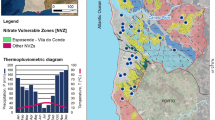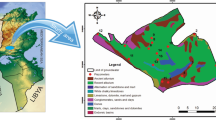Abstract
Water management is one of the most challenges in Algeria, a semi-arid Mediterranean country confronted to a serious water stress. The country will have to endure, beyond 2025, a situation of chronic water penury, adding an excessive pollution of the majority of groundwater reservoirs. The management of water resources by combined approach using hydrogeological model and nitrates evolution model was experimented in the Middle Soummam valley. The alluvial aquifer, offering good hydrodynamic and geometrical characteristics, is over-exploited, providing in drinking water Akbou and Tazmalt cities and irrigation perimeters. If exploitation continues at these steady paces, the depletion of the water resource and the hydrochemical imbalance will be inevitable. On the one hand, the results of hydrodynamic model, based on an increase of the water takings and simulated needs from 24.71 Mm3/year in 2015 into 39.69 Mm3/year in 2030, show a critical withdrawal. The aquifer budget expresses the inversion of flow between the wadi and the aquifer where the wadi feeds the groundwater reservoir. This hydrodynamic inversion was attributed to simulated pumping rates which increased and exceeded 100,000 m3/day, but the aquifer was partially relieved by the weight of the exploitation through Tichy Haf dam. The water management strategy adopted in this study was based on management measures promoting zones, which have been delimited between Tazmalt and Akbou, and containing important water quantities available in the axis of the valley. However, according to the depleted in isotopes of 18O and 2H, which could be explained by the influence of a paleoclimatic effect and suggested that the aquifer recharge would have largely been made under a colder climate, pumped groundwater could be old, and the implementation of new pumping sites has been studied minutely. On the other hand, the hydrogeochemical modelling allowed following nitrates concentrations in order to project their evolution. Four wells on 25 react in face to the imposed conditions in each scenario simulated until 2030, showing inertia of pollution, and confirmed after three series of tests. This inertia would be related to the hydraulic gradients and hydraulic conductivities, aquifer thickness and recharge. The low hydraulic gradients lead to a rather slow flow velocity and thus to an inertia in the dispersion of nitrates, with a mass transport weakened by the hydrodynamic conditions. It is also related to the aquifer thickness; when the aquifer is powerful (65–85 m), the stock of water would be important and allows a dilution process. The reverse is true for the simulated boreholes where the concentrations remain invariant; the aquifer is less powerful (32–37 m). Finally, the recharge effect through the rain was evoked; the aquifer is unconfined, and the rain water and pollution that reached the piezometric level can remain in position in slow hydrodynamic conditions. The methodology was demonstrated through a combination of monitoring and modelling for both water quantity and quality and the importance to use numerical models to support water resources management strategy in the Mediterranean aquifers.







Similar content being viewed by others
References
Ala-aho P, Rossi PM, Isokangas E, Kløve B (2015) Fully integrated surface–subsurface flow modelling of groundwater–lake interaction in an esker aquifer: model verification with stable isotopes and airborne thermal imaging. J Hydrol 522:391–406
Böhlke J-K (2002) Groundwater recharge and agricultural contamination. Hydrogeol J 10:153–179. doi:10.1007/s10040-001-0183-3
Brown J, Bach L, Aldous A, Wyers A, De Gagné J (2010) Groundwater-dependent ecosystems in Oregon: an assessment of their distribution and associated threats. Front Ecol Environ. doi:10.1890/090108
Cartwright I, Weaver T, Cendón DI, Swane I (2010) Environmental isotopes as indicators of inter-aquifer mixing, Wimmera region, Murray Basin, Southeast Australia. Chem Geol 277:214–226
Cartwright I, Gilfedder B, Hofmann H (2013) Chloride imbalance in a catchment undergoing hydrological change: upper Barwon River, southeast Australia. Appl Geochem 31:187–198
Chiang W-H, Kinzelbagh W (2000) 3D–ground water modeling with PMWIN, a simulation system for modeling flow and pollution. Springer, Berlin
Clinckx C (1973) Etude hydrogéologique de la nappe alluviale de la basse Soummam (Sidi Aich - Béjaia). Direction des Etudes de Milieu et de la Recherche Hydraulique, DEMRH, Alger
Clinckx C, Grange R, Grenet B (1974) Etude hydrogéologique de la vallée de l’oued Sahel-Soummam. Direction des Etudes de Milieu et de la Recherche Hydraulique, DEMRH, Alger
Compagnie Générale de Géophysique CGG (1969–1970) Etude hydrogéologique par prospection électrique et sismique dans la vallée de la Soummam. CGG, Alger
Cox ME, James A, Hawke A, Raiber M (2013) Groundwater visualisation system (GVS): a software framework for integrated display and interrogation of conceptual hydrogeological models, data and time-series animation. J Hydrol 491:56–72. doi:10.1016/j.jhydrol.2013.03.023
De Marsily G (1981) Hydrogéologie quantitative. Masson, Paris
DHW (2011) Fiche signalétique de la wilaya : situation du secteur de l’hydraulique. Direction de l’Hydraulique de la Wilaya de Béjaia, Béjaia
Dunn SM, Darling WG, Birkel C, Bacon JR (2012) The role of groundwater characteristics in catchment recovery from nitrate pollution. Hydrol Res 43:560. doi:10.2166/nh.2012.020
Earle S (2015) Physical geology. BCcampus OpenEd, British Columbia
Forster C, Smith L (1988) Groundwater flow systems in mountainous terrain: 2. Controlling factors. Water Resour Res 24:1011–1023. doi:10.1029/WR024i007p01011
Grathwohl P, Rügner H, Wöhling T, Osenbrück K, Schwientek M, Gayler S, Wollschläger U, Selle B, Pause M, Delfs J-O, Grzeschik M, Weller U, Ivanov M, Cirpka OA, Maier U, Kuch B, Nowak W, Wulfmeyer V, Warrach-Sagi K, Streck T, Attinger S, Bilke L, Dietrich P, Fleckenstein JH, Kalbacher T, Kolditz O, Rink K, Samaniego L, Vogel H-J, Werban U, Teutsch G (2013) Catchments as reactors: a comprehensive approach for water fluxes and solute turnover. Environ Earth Sci 69:317–333. doi:10.1007/s12665-013-2281-7
Green TR, Taniguchi M, Kooi H, Gurdak JJ, Allen DM, Hiscock KM, Treidel H, Aureli A (2011) Beneath the surface of global change: impacts of climate change on groundwater. J Hydrol 405:532–560
Kazakis N, Voudouris KS (2015) Groundwater vulnerability and pollution risk assessment of porous aquifers to nitrate: modifying the DRASTIC method using quantitative parameters. J Hydrol 525(2015):13–25
Kettab A (2001) Les ressources en eau en Algérie: stratégies, enjeux et vision. Desalination 136:25–33
Kløve B, Ala-aho P, Bertrand G, Boukalova Z, Ertürk A, Goldscheider N (2011) Groundwater dependent ecosystems. Part I: Hydroecological status and trends. Environ Sci Policy 14:770–781
Kolbe T, Marçais J, Thomas Z, Abbott BW, Raynald de Dreuzy J, Rousseau-Gueutin P, Aquilina L, Labasque T, Pinay G (2016) Coupling 3D groundwater modeling with CFC-based age dating to classify local groundwater circulation in an unconfined crystalline aquifer. J Hydrol. doi:10.1016/j.jhydrol.2016.05.020
Lamari H (2015) Évaluation quantitative et qualitative de la ressource en rau des sous bassins versants de l’wadi Sahel Amont et Aval et de l’wadi Boussellem Aval (Wilaya de Bouira et de Bejaia). Magister Thesis, Université des Sciences et Technologie Houari Boumediene, USTHB Algiers
McDonnell JJ, Sivapalan M, Vaché K, Dunn S, Grant G, Haggerty R, Hinz C, Hooper R, Kirchner J, Roderick ML, Selker J, Weiler M (2007) Moving beyond heterogeneity and process complexity: a new vision for watershed hydrology. Water Resour Res 43:W07301. doi:10.1029/2006WR005467
Meixner T, Manning AH, Stonestrom DA, Allen DM, Ajami H, Blasch KW, Brookfield AE, Castro CL, Clark JF, Gochis DJ, Flint AL, Neff KL, Niraula R, Rodell M, Scanlon BR, Singha K, Walvoord MA (2016) Implications of projected climate change for groundwater recharge in the western United States. J Hydrol 534(2016):124–138. doi:10.1016/j.jhydrol.2015.12.027
Milano M (2012) Changements globaux en Méditerranée impacts sur le stress hydrique et la capacité à satisfaire les demandes en eau. Dissertation, Université Montpellier II, Sciences et Techniques du Languedoc
Plan Bleu (2005) L’Eau. In: Méditerranée, les perspectives du Plan Bleu sur l’Environnement et le Développement. Editions de l’Aube et Plan Bleu, Valbonne, pp 71–107
Plan National de l’Eau (2010) Réalisation de l’étude d’actualisation du Plan National de l’Eau (PNE). SOFRECO, Alger
Raiber M, Webb JA, Bennetts DA (2009) Strontium isotopes as tracers to delineate aquifer interactions and the influence of rainfall in the basalt plains of southeastern Australia. J Hydrol 367:188–199
Raiber M, Webb JA, Cendón DI, White PA, Jacobsen GE (2015) Environmental isotopes meet 3D geological modelling: conceptualising recharge and structurally-controlled aquifer connectivity in the basalt plains of south-western Victoria, Australia. J Hydrol 527:262–280. doi:10.1016/j.jhydrol.2015.04.053
Reilly TE, Harbaugh AW (2004) Guidelines for evaluating ground-water-flow models. Scientific Investigations Report. USGS, Reston, Virginia 30p
Remini B (2010) La problématique de l’eau en Algérie du Nord. Larhyss Journal 8:27–46
Uliana MM, Banner JL, Sharp JM (2007) Regional groundwater flow paths in Trans-Pecos, Texas inferred from oxygen, hydrogen, and strontium isotopes. J Hydrol 334:334–346
Wels Ch, Mackie D, Scibek J (2012) Guidelines for groundwater modelling to assess impacts of proposed natural resource development activities. British Columbia Ministry of Environment, Water Protection and Sustainable Branch, British Columbia
Weyer C, Peiffer S, Schulze K, Borken W, Lischeid G (2014) Catchments as heterogeneous and multi-species reactors: an integral approach for identifying biogeochemical hot-spots at the catchment scale. J Hydrol 519:1560–1571. doi:10.1016/j.jhydrol.2014.09.005
Wood WW, Sanford WE (1995) Eolian transport, saline lake basins, and groundwater solutes. Water Resour Res 31(12):3121–3129
Author information
Authors and Affiliations
Corresponding author
Additional information
This article is part of the Topical Collection on Water Resource Management for Sustainable Development
Rights and permissions
About this article
Cite this article
Kessasra, F., Mesbah, M., Khemissa, Z. et al. Combined hydrogeological and nitrate modelling to manage water resources of the Middle Soummam Aquifer, Northeast of Algeria. Arab J Geosci 10, 368 (2017). https://doi.org/10.1007/s12517-017-3160-4
Received:
Accepted:
Published:
DOI: https://doi.org/10.1007/s12517-017-3160-4




